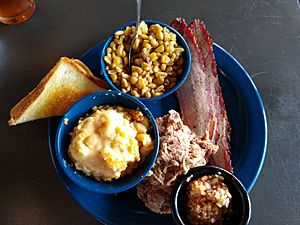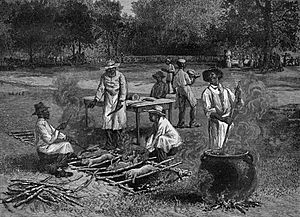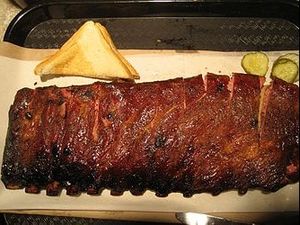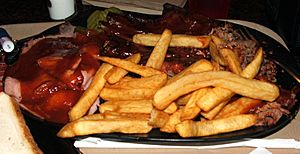Barbecue in the United States facts for kids
In the United States, barbecue means cooking meat outdoors over a fire. This is often called pit barbecue, and the cooking area is the barbecue pit. This way of cooking gives meat a special smoky taste. While barbecue sauce is often used, it's not always needed for many styles.
Many barbecue restaurants, especially those outside the Southern US, are started by people from the South. In the South, barbecue is more than just cooking; it's a big part of the culture. There are many different styles across regions, and people even have strong rivalries in barbecue cooking contests!
Contents
What is Barbecue?
Barbecue usually has three main parts: the meat, the wood smoke, and sometimes a sauce or seasoning.
The Meat in Barbecue
The most common meat for barbecue is pork, especially pork ribs and pulled pork from the pork shoulder. In Texas, beef is more popular, especially brisket.
How Meat is Cooked
Barbecue uses a method called smoke cooking. This is different from cold smoking. In smoke cooking, meat is cooked slowly over an indirect fire, meaning the meat isn't directly over the flames. The temperature is usually around 250°F (121°C). This long, slow cooking can take up to 18 hours! It makes the meat super tender and juicy.
This process also creates a special red line just under the meat's surface. This "smoke ring" happens when the meat reacts with smoke from the wood. It's a sign of real barbecue and gives the meat its smoky flavor.
The Wood for Smoke
The type of wood used is very important because it flavors the food. Different woods give different tastes. So, the kind of wood available in a region often shapes the taste of its barbecue.
- Strong smoke flavor: Hardwoods like hickory, mesquite, and different kinds of oak give a strong smoky taste.
- Milder, sweeter taste: Woods like maple, alder, pecan, and fruit woods such as apple, pear, and cherry give a lighter, sweeter flavor.
Stronger woods are often used for pork and beef. Lighter woods are better for fish and chicken. Some recipes even use unusual things like grapevine for a sweet flavor, or sassafras (which tastes like root beer) for a unique smoky taste.
Barbecue Sauce and Rubs
The last part of barbecue, which is often optional, is the barbecue sauce. There are so many kinds! Some are thin and peppery, like vinegars. Others are thick and sweet, made with tomato and molasses. Some are even based on mustard and can be very spicy!
Sauce can be used in different ways:
- As a marinade before cooking.
- Brushed on during cooking.
- Added after cooking.
- Served at the table for dipping.
Another option is a dry rub. This is a mix of salt and spices put on the meat before it's cooked.
Where Barbecue Comes From
American barbecue has a long history, going back to colonial times. The first mention of it was in 1672. Even George Washington wrote about going to a "barbicue" in 1769! As the country grew westward and northward, barbecue spread with it.
The main area for barbecue is the southeastern United States. This includes states like Texas, Oklahoma, Missouri, Kentucky, Virginia, and all the way to the Atlantic Ocean.
Even though you can find barbecue outside this area, most of the top barbecue restaurants are in these 14 core states. Barbecue as we know it today started in the South. Cooks there learned to slow-cook tough cuts of meat over fire pits to make them tender.
Many barbecue restaurants, especially older ones, are in small, simple places often called "hole-in-the-wall" spots or "rib joints." They might have strange hours, sometimes closing when they run out of ribs for the day. But even with these quirks, they often have very loyal customers!
Barbecue is deeply connected to Southern cooking and culture. Native Americans in Georgia were using similar cooking methods centuries ago. The word "barbecue" comes from the Spanish word barbacoa, which first meant "to preserve meat by drying or slow roasting." Over time, it came to mean the specific cooking style we know today.
Today, barbecue is about bringing people together and enjoying good food. It's a very important part of America's food traditions. Parts of the Midwest, like Kansas City, Missouri, also have their own barbecue styles. Kansas City barbecue, for example, uses many different meats, sweet and thick sauces, and dry rubs. This style developed from cooking techniques brought by freed slaves and from Texas cattle drives in the late 1800s.
Barbecue as a Tradition
Barbecue has been a big part of American culture, especially in the South, since colonial times. It's one of the most traditional foods in the United States. While many festive foods are for specific holidays, barbecue can be enjoyed any day. It's often served on the Fourth of July, but it's not just for that day.
Barbecues bring people together and create a fun, bonding experience. They often take place outdoors, which can feel like an escape to nature. Barbecues can be small, informal backyard gatherings or large, all-day events for many people.
The idea of barbecue has been popular for a long time. As author Andrew Warnes said, its "mythology of savagery and freedom, of pleasure, masculinity and strength" helps explain why barbecues are still so loved. By the 1800s, barbecues became a main way to celebrate public events in the US, especially the Fourth of July.
As the US expanded, barbecue traditions spread with the people. Today, barbecues in different regions have different foods, but they all share the idea of cooking outdoors over a fire. Barbecue has even taken on new meaning with the rise of competitive barbecue. People compete by cooking barbecue, and judges decide who is best. These contests are held all over the country, often in big open areas where spectators can watch and enjoy barbecue too.
The pig became a key part of Southern cooking in the 1700s. Pigs are easy to raise and grow quickly. Because pigs were so common in the South, they became a symbol of Southern culture and barbecue. Pigs were also very important for the economy. By 1860, pigs and other livestock in the South were worth twice as much as the cotton crop!
Pigs and barbecue were not just important for money. Many pigs were set aside for large gatherings, like political rallies, church events, and harvest festivals. Barbecues have been part of American history since the very first Independence Day celebration. In the early days, Independence Day was a formal gathering. As settlers moved to western territories, these traditions spread. By the 1800s, barbecue became even more important in public celebrations and political events, especially in the South and Midwest.
Main Barbecue Styles
While there are many barbecue styles, four main ones are often talked about: the Carolinas and Memphis, which mostly use pork, and Kansas City and Texas, which use beef as well as pork. Pork is the most common meat, followed by beef. Sometimes chicken or turkey are also used. In some areas, like Owensboro, Kentucky, you might even find lamb and mutton.
Carolinas

Carolina barbecue is made from pork. It's usually served pulled, shredded, or chopped, but sometimes sliced. The meat might be rubbed with spices before smoking. During smoking, it's often brushed with a mix of spices and vinegar. This is probably the oldest style of American barbecue. Hardwoods like oak or hickory are usually used for smoking.
North Carolina Styles
Two main styles are found in North Carolina:
- Eastern North Carolina barbecue: This style uses the "whole hog," meaning the entire pig is barbecued. The meat from all parts of the pig is chopped and mixed together. It uses a thin sauce made of vinegar and spices, often just cayenne pepper.
- Western North Carolina barbecue: This style uses only the pork shoulder, which is mostly dark meat. It uses a vinegar-based sauce that also has some tomato. This style is also called Piedmont style or Lexington style, after the town of Lexington, North Carolina, which has many barbecue restaurants and a big barbecue festival.
South Carolina Style
South Carolina has its own special sauce. In the area from Columbia to Charleston, barbecue often uses a yellow "Carolina Gold" sauce. This sauce is made from yellow mustard, vinegar, brown sugar, and other spices.
Kansas City
Barbecue came to Kansas City, Missouri from Memphis, brought by a man named Henry Perry. The Kansas City style is known for using a wide variety of meats, including beef, pork, and lamb. It also puts a lot of focus on its special sauce and french fries.
The meat is smoked with a dry rub, and the sauce is served at the table. Kansas City barbecue is rubbed with spices, slow-smoked over different woods, and served with a thick, tomato-based barbecue sauce. This sauce is a key part of KC-style barbecue. Famous Kansas City barbecue restaurants include Arthur Bryant's (which came from Perry's original place) and Gates Bar-B-Q, which has spicier sauces.
Memphis
Memphis barbecue mainly features two dishes: ribs and barbecue sandwiches. Ribs can be "wet" or "dry." Wet ribs are brushed with sauce before and after cooking. Dry ribs are seasoned with a dry rub. Barbecue sandwiches in Memphis are usually pulled pork (shredded by hand, not chopped) served on a simple bun with barbecue sauce and coleslaw.
People in Memphis also like to put pulled pork on many other dishes, creating things like barbecue salad, barbecue spaghetti, barbecue pizza, or barbecue nachos!
Texas
There are four main regional styles of barbecue in Texas:
- East Texas style: This is similar to Southern barbecue and is found in many cities.
- Central Texas "meat market style": This style started in the butcher shops of German and Czech immigrants.
- West Texas "cowboy style": This involves cooking directly over mesquite wood. It uses goat and mutton as well as beef.
- South Texas barbacoa: In this style, a cow's head is cooked, originally underground.
Other Barbecue Regions
Alabama
Alabama is famous for its smoked chicken. This chicken is traditionally served with Alabama white sauce. This sauce is made with mayonnaise, vinegar, black pepper, and other spices. It was created by Bob Gibson in Decatur, Alabama, in the 1920s. The chicken is smoked first, then dipped or coated in the white sauce. The sauce is also served at the table to put on other foods.
California
The first people to use buried cooking pits in North America were Native Americans thousands of years ago, including tribes in California. Later, when California was Spanish and Mexican territory, large ranches had many cattle. After they used the hides and fat, they would cook the leftover meat in large pit barbecues. After 1850, when California became a state, the local people continued this outdoor cooking for fiestas.
The Santa Maria-style barbecue in California's Central Coast region is known for its tri-tip beef rump. This meat is grilled over a pit of red oak wood and simply seasoned with salt and garlic. You often see versions of this cooked from trailers at farmers markets. It's usually served with pinto beans, pico de gallo salsa, and tortillas.
Hawaii
The cooking traditions of the native people of Polynesia became the traditional Hawaiian luau. This was made famous by tourism in the 1900s.
The Korean immigrant community also greatly influenced Hawaiian barbecue. Serving barbecued meat with sweet garlic teriyaki sauce over steamed vegetables and rice is common in both Hawaiian and Korean barbecue. You can find Hawaiian versions of Korean dishes like bulgogi and bibimbap, made with local ingredients like pineapple. L&L Hawaii Barbecue is a restaurant chain from Honolulu that serves traditional Hawaiian barbecue across the country. Their main dish is a Hawaiian plate lunch, which includes rice, macaroni salad, and a hot meat dish.
St. Louis
A key part of barbecuing in St. Louis is pork steak, which is sliced from the pig's shoulder. Even though Missouri is now considered part of the Midwest, it was first settled by people from the Southern states like Kentucky, Virginia, and Tennessee.
These early settlers brought strong barbecue traditions. Even though many German and Scandinavian immigrants came later, the Southern influences stayed, especially in central Missouri.
St. Louis style barbecue sauce is mildly sweet, tart, and spicy, with a tomato base. Unlike many other barbecue sauces, the St. Louis style usually doesn't contain liquid smoke.
Other States
Other regions in the main barbecue states often mix styles from their neighbors. Southern barbecue is also found outside these core states, and new variations are always appearing. Since these places have less local tradition, restaurants might offer a mix of styles, like Carolina pulled pork and Texas brisket on the same menu. They might also create their own unique dishes or add elements from other types of food.
Barbecue Competitions
There are many barbecue competitions held across the country. Groups like the Florida BBQ Association list contests happening all year. Visitors can attend these contests, and some even offer classes where you can become a certified barbecue judge!
Hundreds of barbecue competitions happen every year, from small local events to huge festivals. The American Royal World Championship contest, with over 500 teams, is the largest in the United States. Another big event is the Houston BBQ world championship contest in Texas. In May, the Memphis World Championship Barbecue Cooking Contest is also very popular. There's even a contest just for sauces, called the Diddy Wa Diddy National Barbecue Sauce Contest.
The nonprofit Kansas City Barbeque Society, or KCBS, approves over 300 barbecue contests each year in 44 different states. Even though it's called "Kansas City," the KCBS judges all styles of barbecue. They have different categories for ribs, brisket, pork, and chicken. KCBS also teaches classes across the country to help people improve their barbecue skills and become certified judges.
Images for kids






